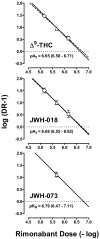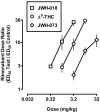JWH-018 and JWH-073: Δ⁹-tetrahydrocannabinol-like discriminative stimulus effects in monkeys - PubMed (original) (raw)
JWH-018 and JWH-073: Δ⁹-tetrahydrocannabinol-like discriminative stimulus effects in monkeys
Brett C Ginsburg et al. J Pharmacol Exp Ther. 2012 Jan.
Abstract
Products containing naphthalen-1-yl-(1-pentylindol-3-yl) methanone (JWH-018) and naphthalen-1-yl-(1-butylindol-3-yl) methanone (JWH-073) are emerging drugs of abuse. Here, the behavioral effects of JWH-018 and JWH-073 were examined in one behavioral assay selective for cannabinoid agonism, rhesus monkeys (n = 4) discriminating Δ⁹-tetrahydrocannabinol (Δ⁹-THC; 0.1 mg/kg i.v.), and another assay sensitive to cannabinoid withdrawal, i.e., monkeys (n = 3) discriminating the cannabinoid antagonist rimonabant (1 mg/kg i.v.) during chronic Δ⁹-THC (1 mg/kg s.c. 12 h) treatment. Δ⁹-THC, JWH-018, and JWH-073 increased drug-lever responding in monkeys discriminating Δ⁹-THC; the ED₅₀ values were 0.044, 0.013, and 0.058 mg/kg, respectively and the duration of action was 4, 2, and 1 h, respectively. Rimonabant (0.32-3.2 mg/kg) produced surmountable antagonism of Δ⁹-THC, JWH-018, and JWH-073. Schild analyses and single-dose apparent affinity estimates yielded apparent pA₂/pK(B) values of 6.65, 6.68, and 6.79 in the presence of Δ⁹-THC, JWH-018, and JWH-073, respectively. In Δ⁹-THC-treated monkeys discriminating rimonabant, the training drug increased responding on the rimonabant lever; the ED₅₀ value of rimonabant was 0.20 mg/kg. Δ⁹-THC (1-10 mg/kg), JWH-018 (0.32-3.2 mg/kg), and JWH-073 (3.2-32 mg/kg) dose-dependently attenuated the rimonabant-discriminative stimulus (i.e., withdrawal). These results suggest that Δ⁹-THC, JWH-018, and JWH-073 act through the same receptors to produce Δ⁹-THC-like subjective effects and attenuate Δ⁹-THC withdrawal. The relatively short duration of action of JWH-018 and JWH-073 might lead to more frequent use, which could strengthen habitual use by increasing the frequency of stimulus-outcome pairings. This coupled with the possible greater efficacy of JWH-018 at cannabinoid 1 receptors could be associated with greater dependence liability than Δ⁹-THC.
Figures
Fig. 1.
Discriminative stimulus effects of Δ9-THC, JWH-018, and JWH-073 as a function of dose (left) and time (right). Abscissae: vehicle or dose in milligram per kilogram of body weight (left) and time in hours (right). Ordinates: mean (± S.E.M.) percentage of responding on the Δ9-THC lever (top) and mean (± S.E.M.) response rate expressed as a percentage of control (VEH training days) rate [rate (% control)] (bottom).
Fig. 2.
Discriminative stimulus effects of Δ9-THC (left), JWH-018 (center), and JWH-073 (right): antagonism by rimonabant. Abscissae: dose in milligram per kilogram of body weight or vehicle (VEH). Ordinates: mean (± S.E.M.) percentage of responses on the Δ9-THC lever (top) and mean (± S.E.M.) response rate expressed as a percentage of control (VEH training days) rate [rate (% control)]. The control dose-response curves for Δ9-THC, JWH-018, and JWH-073 are replotted from Fig. 1.
Fig. 3.
Schild plots for Δ9-THC (top) and JWH-018 (middle) and a log (DR-1) value for JWH-073 (bottom) constructed from the mean data shown in Fig. 2. Abscissae: negative logarithm of the dose in moles per kilogram. Ordinates: mean (± S.E.M.) logarithm of the dose ratio −1. Schild plots were constructed from the unconstrained slopes (dashed lines) and by constraining the slopes to −1 (solid lines).
Fig. 4.
Discriminative stimulus effects of rimonabant: attenuation by Δ9-THC (left), JWH-018 (center), and JWH-073 (right). Abscissae: dose of rimonabant in milligram per kilogram of body weight or vehicle (VEH). Ordinates: mean (± S.E.M.) percentage of responses on the rimonabant lever (top) and mean (± S.E.M.) response rate expressed as a percentage of control (VEH training days) rate [rate (% control)] (bottom). The control dose-response curve for rimonabant is the same in each panel.
Fig. 5.
Magnitude of rightward shift in the rimonabant dose-response function expressed as a function of JWH-018, Δ9-THC, and JWH-073 dose. Abscissa: dose in milligram per kilogram of body weight. Ordinate: mean (± S.E.M.) rightward shift in the rimonabant dose-response function, calculated as the rimonabant ED50 value after pretreatment with a cannabinoid agonist divided by the control rimonabant ED50 value.
Similar articles
- Apparent Affinity Estimates and Reversal of the Effects of Synthetic Cannabinoids AM-2201, CP-47,497, JWH-122, and JWH-250 by Rimonabant in Rhesus Monkeys.
Hruba L, McMahon LR. Hruba L, et al. J Pharmacol Exp Ther. 2017 Aug;362(2):278-286. doi: 10.1124/jpet.117.240572. Epub 2017 May 22. J Pharmacol Exp Ther. 2017. PMID: 28533288 Free PMC article. - Rimonabant-induced Delta9-tetrahydrocannabinol withdrawal in rhesus monkeys: discriminative stimulus effects and other withdrawal signs.
Stewart JL, McMahon LR. Stewart JL, et al. J Pharmacol Exp Ther. 2010 Jul;334(1):347-56. doi: 10.1124/jpet.110.168435. Epub 2010 Apr 7. J Pharmacol Exp Ther. 2010. PMID: 20375197 Free PMC article. - JWH-018 in rhesus monkeys: differential antagonism of discriminative stimulus, rate-decreasing, and hypothermic effects.
Rodriguez JS, McMahon LR. Rodriguez JS, et al. Eur J Pharmacol. 2014 Oct 5;740:151-9. doi: 10.1016/j.ejphar.2014.06.023. Epub 2014 Jun 24. Eur J Pharmacol. 2014. PMID: 24972243 Free PMC article. - Discriminative Stimulus Properties of Phytocannabinoids, Endocannabinoids, and Synthetic Cannabinoids.
Wiley JL, Owens RA, Lichtman AH. Wiley JL, et al. Curr Top Behav Neurosci. 2018;39:153-173. doi: 10.1007/7854_2016_24. Curr Top Behav Neurosci. 2018. PMID: 27278640 Review. - Cannabis use, abuse, and withdrawal: Cannabinergic mechanisms, clinical, and preclinical findings.
Kesner AJ, Lovinger DM. Kesner AJ, et al. J Neurochem. 2021 Jun;157(5):1674-1696. doi: 10.1111/jnc.15369. Epub 2021 May 16. J Neurochem. 2021. PMID: 33891706 Free PMC article. Review.
Cited by
- Δ(9)-Tetrahydrocannabinol acts as a partial agonist/antagonist in mice.
Paronis CA, Nikas SP, Shukla VG, Makriyannis A. Paronis CA, et al. Behav Pharmacol. 2012 Dec;23(8):802-5. doi: 10.1097/FBP.0b013e32835a7c4d. Behav Pharmacol. 2012. PMID: 23075707 Free PMC article. - Interactions between opioids and cannabinoids: Economic demand for opioid/cannabinoid mixtures.
Maguire DR, France CP. Maguire DR, et al. Drug Alcohol Depend. 2020 Jul 1;212:108043. doi: 10.1016/j.drugalcdep.2020.108043. Epub 2020 May 12. Drug Alcohol Depend. 2020. PMID: 32497977 Free PMC article. - Adverse Effects of Synthetic Cannabinoids: Management of Acute Toxicity and Withdrawal.
Cooper ZD. Cooper ZD. Curr Psychiatry Rep. 2016 May;18(5):52. doi: 10.1007/s11920-016-0694-1. Curr Psychiatry Rep. 2016. PMID: 27074934 Free PMC article. Review. - Moving around the molecule: relationship between chemical structure and in vivo activity of synthetic cannabinoids.
Wiley JL, Marusich JA, Huffman JW. Wiley JL, et al. Life Sci. 2014 Feb 27;97(1):55-63. doi: 10.1016/j.lfs.2013.09.011. Epub 2013 Sep 23. Life Sci. 2014. PMID: 24071522 Free PMC article. Review. - Apparent CB1 Receptor Rimonabant Affinity Estimates: Combination with THC and Synthetic Cannabinoids in the Mouse In Vivo Triad Model.
Grim TW, Morales AJ, Thomas BF, Wiley JL, Endres GW, Negus SS, Lichtman AH. Grim TW, et al. J Pharmacol Exp Ther. 2017 Jul;362(1):210-218. doi: 10.1124/jpet.117.240192. Epub 2017 Apr 25. J Pharmacol Exp Ther. 2017. PMID: 28442584 Free PMC article.
References
- Balster RL, Prescott WR. (1992) Δ9-Tetrahydrocannabinol discrimination in rats as a model for cannabis intoxication. Neurosci Biobehav Rev 16:55–62 - PubMed
- Boisse NR, Okamoto M. (1978) Physical dependence to barbital compared to pentobarbital. IV. Influence of elimination kinetics. J Pharmacol Exp Ther 204:526–540 - PubMed
- Breivogel CS, Childers SR. (2000) Cannabinoid agonist signal transduction in rat brain: comparison of cannabinoid agonists in receptor binding, G-protein activation, and adenylyl cyclase inhibition. J Pharmacol Exp Ther 295:328–336 - PubMed
Publication types
MeSH terms
Substances
LinkOut - more resources
Full Text Sources




